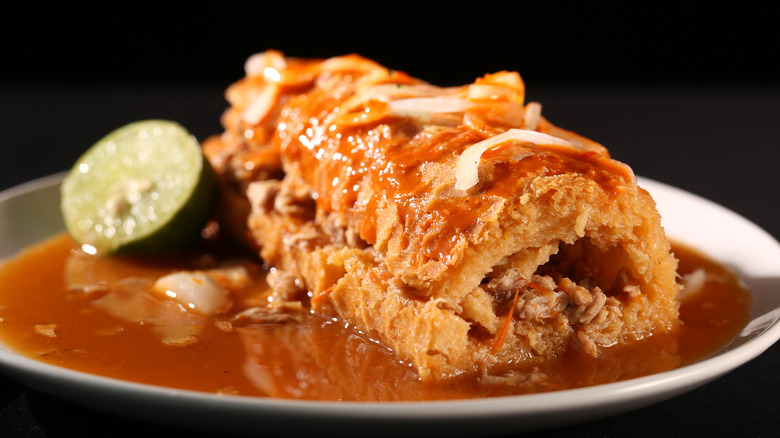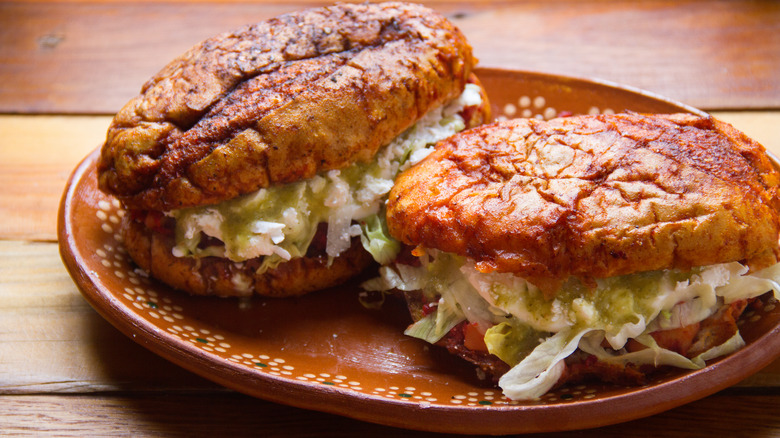What Makes Mexican Tortas Unique?
A torta in Mexico is broadly similar to a sandwich in the U.S., in that both feature a variety of fillings and toppings sandwiched by bread. However, there is a wide disparity between the items typically offered at a Mexican tortería, and those found in an American-based sandwich shop. The torta ahogada, a famed "drowned" torta associated with Guadalajara, for example, features a pork-filled sandwich smothered in spicy salsa. It's the rare sandwich that can legitimately be eaten with a spoon.
However, tortas in Mexico aren't necessarily wet sandwiches. But served hot, cold, or otherwise, they are quintessentially Mexican, with deep cultural and historical roots. Whether the uniquely Mexican sandwich was really invented in Mexico City in 1892 by 11-year-old comfort food prodigy Armando Martínez Centurión, as some might believe, the torta, like the taco and tamal, is a foundational part of the nation's street food culture.
These three iconic foods, in fact, often display some degree of overlap in terms of flavor and preparation. The torta guajolota, for instance, is simply a variation of the classic tamal, with a sandwich wrapping in place of the traditional corn husks or banana leaves. What really makes Mexican tortas unique, however, isn't just their regionally distinctive flavors, with frequent use of toppings like avocados and chile spiced salsas. It's the distinctive breads like bollilo and telera that are used to sandwich them.
Traditional breads used to make Mexican tortas
Although there are innumerable torta recipes and variations in Mexico, there are only a few traditional bread types, the most common being the bolillo and the telera. The creation of each date to the French Intervention period in Mexico when the country was briefly ruled by the Habsburg Emperor Maximilian. Among the occupiers was a Belgian baker named Camille Pirotte, who is credited with introducing baguette-style breadmaking to Mexico during the 1860s. His name lives on in the birote, the sourdough-style bread that is used in the making of Guadalajara's famed torta ahogada.
Pirotte is also credited with inspiring the bolillo, the torpedo-like bread with a crunchy crust and soft interior that is a staple element of many Mexican tortas. The bolillo is often used, for example, for tortas de tamal, as well as the popular torta Cubana, which despite its name is distinctly Mexican, with a multitude of meaty toppings that can include breaded pork loin, ham, salchicha, chorizo, cheese, fried egg, and more.
Telera, a larger and rounder bread type immediately recognizable by the two long lines cut along its top, also came about during the French Intervention period, with its roots in Puebla. The soft bread is a popular ingredient in numerous tortas, including the torta Cubana and the torta de milanesa, the latter of which is named for its breaded and fried meat.
The history of Mexican tortas
There were two French interventions in Mexico during the 19th century. The first was the so-called Pastry War, which was a short-lived conflict in the late 1830s based on monetary concessions to which the French felt entitled. Despite its culinary name, the bread types now used for Mexican tortas evolved during the next French Intervention period, from 1861 to 1867. It was within this timeframe that Belgian baker Camille Pirotte came to Mexico. Pirotte's contribution to Mexican culture was profound, as he directly influenced the creation of the bolillo and birote bread types used in torta making.
There is historical evidence for tortas in the form of a newspaper advertisement dating to 1864. The ad mentions a torta compuesta, meaning a mix of fillings. Most sources, however, credit the invention of tortas to Armando Martínez Centurión in 1892. His name, in fact, was given to the first torteria ever to open in Mexico City, Tortería Armando. Amazingly, the business is still going strong more than 130 years later, although there have been a few relocations throughout the years.
Martínez's early tortas were not the same as the torta variations commonly sold in Mexico today. The torta ahogada, or drowned torta, for example, is thought to have been invented in Guadalajara during the 1920s. The torta Cubana, meanwhile, was created on Mexico City's Calle Republica de Cuba (the origin of its foreign-sounding name) during the 1950s.
Popular Mexican torta variations
The torta ahogada and torta Cubana are iconic torta variations, as are the guajolota (torta de tamal) and torta de milanesa. There are several other popular torta styles worth mentioning, however. Most notably, the pambazo, a chorizo-based torta made with telera bread that is dipped in guajillo chile salsa before being fried. The pambazo may have been created in Toluca, but over the years it has also become synonymous with Mexico City.
Mexico City is also associated with the torta pepito, in which marinated slices of grilled arrachera (flank steak) are paired with avocado on bollilo bread. It's not uncommon, of course, for cities to be associated with specific tortas in this way. Puebla, for example, is associated with several tortas, including the tortas cemita and pelona. The former takes its name from its sesame-seeded bread, and features meat (generally either ham or breaded beef) and shredded quesillo cheese, with toppings of onion, avocado, chipotle, and a native herb known as papalo.
Other regional Mexican favorites include the torta guacamaya, a León specialty named for a parrot. As the moniker would suggest, it's among the more colorful tortas, with bolillo bread cosseting its chicharrón, avocado, pico de gallo, chile de árbol, and lime. Tamaulipas' own torta de la barda, meanwhile, is a meaty sandwich that adds beans to a mix of shredded beef, ham, chorizo, and queso de puerco. Avocado and salsa verde are also included in the bolillo bread sandwich.



